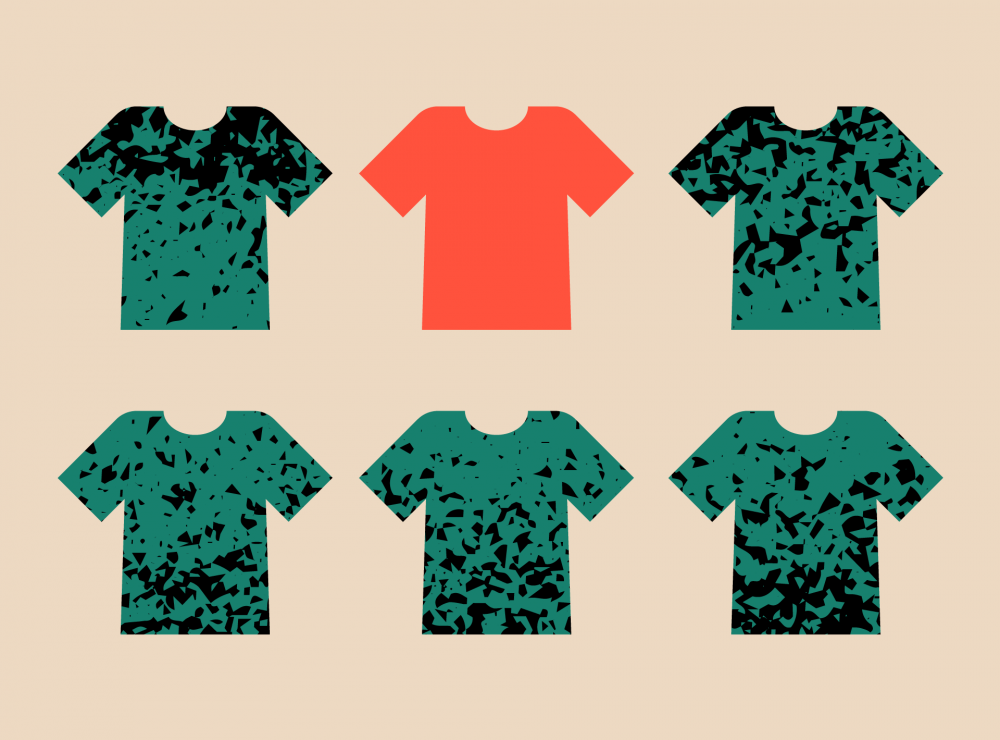The environmental argument is meaningful to consumers, so firms are taking sustainability initiatives willingly and eagerly. But unfortunately, some brands are artificially greening their image. That is “greenwashing,” and it is a plague that strongly affects the fashion industry’s marketing.
The report “License to Greenwash” (by Changing Markets Foundation), which analysed ten global certification labels and industry initiatives, shows that the climate promises of fashion industry bigwigs need to be approached with caution. It turns out that a significant portion of the certifications and multi-stakeholder schemes that companies proudly boast about are only used to pose as pro-environmental measures. So does this mean that sustainability in the fashion industry is just empty promises? We check!
The number of voluntary initiatives undertaken by large and small fashion companies has increased dramatically over the past few years. Consumers may therefore feel that apparel companies are taking sustainability issues very seriously. However, a market study conducted by the Changing Markets Foundation found that despite numerous declarations by apparel manufacturers, the industry’s environmental impact has worsened significantly over the same time.
Does this mean that sustainability in the fashion industry is just empty promises? Let’s check!
Fashion industry resistant to regulation
Countries are increasingly introducing a variety of regulations to improve the environment. A prime example, among others, is the ban in some countries on older diesel and gasoline cars entering city centers. So how is it possible that now that we are increasingly concerned with improving the condition of our planet, the fashion industry has so far remained free of any legal pro-environmental mandates or bans?
As the report reveals fashion brands have effectively lulled the vigilance of more than just their consumers. Lawmakers, too, are convinced that the fashion industry is undertaking numerous sustainability initiatives, and there is no need for top-down regulation of their activities.
More than 100 sustainability certification schemes have been established in the textile industry, giving us a false sense of security that the industry is undertaking pro-environmental initiatives. The Changing Markets Foundation report in question examines 10, the most recognizable, with a focus on those that claim to address circularity, overproduction, eliminating fast fashion, or fighting the use of toxic chemicals in production.
The schemes discussed in the report vary in nature, but two features they have in common are voluntary and, more importantly, enjoy a high level of public interest and confidence. Therefore, the report’s creators decided to check whether we can trust the fashion industry’s actions. The results of the information are astonishing. It turns out that numerous brand declarations are pure “greenwashing.”
Greenwashing – a green lie and harmful practice
Many companies use green initiatives in their messages to consumers, but they are often bogus. Such practices by brands of various industries have become so common in recent years that they have been given the name “greenwashing.”
Greenwashing can be defined as marketing efforts consciously undertaken by brands, targeting customers seeking goods produced by ecological and environmental principles. The companies’ communications are intended to give the public the impression that both the manufacture of products and the company’s operations are in harmony with nature and the best pro-environmental practices.
That is a harmful phenomenon because it misleads consumers. At the same time, it causes many industries (not only the fashion industry) to remain outside any external scrutiny of their manufacturing practices. As a result, decision-makers do not take action because they are convinced that companies aware of the scale of the problem will take the initiatives themselves. However, as this report shows, this is not entirely true.

Greenwashing in the fashion industry
Let’s take a closer look at the fashion industry, which seems to have a license for greenwashing. Why do the actions of big brands often raise no suspicion?
Most companies that engage in greenwashing are giant corporations that employ top PR specialists and allocate substantial financial resources to marketing campaigns. With almost unlimited funds, brands establish partnerships with well-known musicians and artists or other recognizable people who promote their movements with their faces, instilling consumer confidence.
Of course, not all actions of clothing manufacturers are intended practices. Sometimes assessing specific initiatives as greenwashing is due to a poor understanding of the brand’s message. However, there is no doubt that there is often a second bottom behind beautiful-sounding slogans. The introduction of paper shopping bags into which sandblasted jeans are placed, the production of clothes from supposedly organic fibres, applied only to a small part of the collection, or the organisation of recycling campaigns by fast-fashion brands are just a slice of the many absurdities that happen in greenwashing.
Well, it’s time to revisit the findings of the Changing Markets Foundation’s report and look at the five most surprising unfair “green” practices of clothing brands.
Apparel manufacturers’ biggest environmental sins
The survey and systems analysis in the Changing Markets Foundation’s report was meant to assess whether the fashion industry’s certification systems, labels, and initiatives are up to the task set for them and whether they reflect the public’s trust. Unfortunately, the report revealed many inaccuracies and absurdities. We have selected 5 of the most glaring cases from it.
1. Consumption of polyester fiber is on the rise
Fashion brands are very eager to declare their sustainability efforts. However, over the past 20 years, the fashion industry has been one of the most polluting sectors, resource-intensive and energy-wasting.
We are experiencing a climate crisis, and the fashion industry’s first raw material is polyester fibres, for which gas and oil are used. Can this trend be reconciled with the claimed progress toward reducing the environmental impact of this economic sector? Unfortunately not, which is why none of the programs analysed address this problem.
2. Garments from return programs end up in landfills
Brands are increasingly implementing return programs at their stores to minimise the amount of trash generated by clothing. However, what happens to the returned items? The clothes are shipped to countries in the Global South, where there is already too much second-hand clothing. That results in textiles ending up in landfills or being incinerated.
The Textile Exchange report also found that 52% of the companies surveyed have little or no knowledge of what happens to the clothing after it is returned. This fact is certainly not indicative of the pro-environmental attitude of apparel brands.
3. Modern technology diverts attention
Technology is a critical enabler in moving toward a circular business model. But, in reality, it is just another tactic to distract consumers and lawmakers. An example is the launch of the H&M Group’s Looop machine, which cannot handle polyester or polyester blend garments.
What’s more, it’s estimated that a Looop machine would take nearly 50,000 years to handle a week’s worth of waste from the market or about 6 million garments. That makes such technological solutions almost useless, but in marketing communications, they are presented by brands as evidence of the company’s responsible approach.
4. Certified clothing? Yes, but only selected models.
Partnerships are increasingly forming in the fashion industry to provide and use recycled fibres to avoid using virgin materials for clothing. Brands eagerly join such programs, publish information about it, and mark their clothes with appropriate certificates.
The initiative is laudable, but as the published report shows, in most cases, the certified clothes make up only a tiny part of all staff sold in fast-fashion brands’ stores. That is, of course, better than leaving this waste to nature, but acting on such a small scale does not eliminate the problem of plastic flooding into the environment.
5. The initiative is already there; only the effects will be in the future
As the report shows, some of the programs and initiatives that fashion brands proudly boast about have one fundamental flaw: the effect we’ll see in the future. Part of them has been initiated only to divert the attention of consumers and lawmakers. Some of the programs intend to achieve their goals only in 2030!
Moreover, the analysis often emphasised that most programs depend on each other and that the brands involved in the projects are partners or collaborators. That leads to a highly interconnected network of influence and cross-promotion that can stifle the opposition and healthy debate necessary for progress.

What can we do to counter greenwashing in the fashion industry and more?
The report leaves no doubt. Most pro-environmental initiatives undertaken by fashion brands are just a smokescreen and a distraction to avoid introducing legal regulations. In other words, fashion companies have a license for greenwashing. So the question arises, what can we as consumers do to stop this fast-fashion machine?
First and foremost, it is essential to communicate our dissatisfaction with the trend the industry is presenting. The actions of brands are not just a response to demand; they influence the creation of needs through the marketing activities they undertake. Therefore, as customers, we should speak out about the need for change and implement educational activities. Individual decisions of each of us are also important. Let’s choose those brands that take steps toward sustainable production rather than choosing to greenwashing in communication. It is our everyday decisions that can send a signal to both brands and governments and lead to change. If you care about the fate of our planet, check out the Changing Markets project, which reveals several greenwashing tactics used on products, designs, and advertisements, among others in the fashion industry. Our small, everyday decisions can affect the kind of world we will live in in the coming years and what we will leave for future generations.
If you want to grow your brand’s awareness and ensure its consistency, you need to take care of a better understanding of the brand inside your organisation. The larger it is, the more demanding the task. So, if you need support just drop us a line. We look forward to working together.

